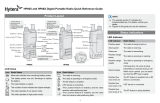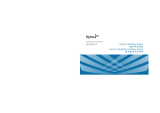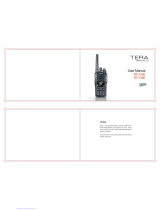Page is loading ...

Preface
Thank you for purchasing Hytera PT580H Plus F4 TETRA digital terminal. The terminal
has a large translucent TFT color display, and supports both TMO and DMO modes. The
benefits that PT580H Plus F4 can deliver you will dramatically improve your working
efficiency.
To derive optimum performance from the terminal, please read the Safety Information
Booklet and Owner’s Manual carefully before use.

1
Icon Information
The following icons are available through this manual:
Caution: indicates situations that could cause damage to your terminal.
Note: indicates tips that can help you make better use of your terminal.
Term Explanation
Key Operation
Short press: to press a key and release it quickly.
Long press: to press and hold down a key for above 1.5 seconds.
Hold down: to press a key and remain holding it down.
Individual Call
Individual call is a simplex or duplex call initiated by a single user to another user,
involving the calling party and the called party only.
Group Call
Group call is a simplex call initiated by a single user to a group of users, involving the
calling party and all the group members.
Telephone Call
Telephone call is usually a full duplex call initiated between PT580H Plus F4 and a
PSTN subscriber (such as telephone user or mobile phone user).
To send or receive telephone calls, the terminal must operate in TMO mode, and
must be authorized to access public network through PSTN gateway. Telephone call
is a network service. For more details and availability of the service, please contact
your service provider.
Emergency Call
Emergency call has the highest priority, and is very helpful for the user to request help
when emergency occurs. Generally, it is set to group call type. Emergency call can
break off any non-emergency calls in progress.

2
DMO (Direct Mode Operation)
DMO mode allows terminals to communicate directly with each other in simplex mode,
without network restriction. But functions that require network access, such as
telephone call and short message, will be disallowed.
TMO (Trunked Mode Operation)
TMO mode allows terminals to communicate with each other via the TETRA network,
in half duplex or full duplex mode. Functions that require network access are
supported.
To operate in TMO mode, the terminal must be granted authorization by your service
provider, and must be within the network coverage.
Air Interface Encryption
An encryption method helpful for protecting message transmitted over the air. It
encrypts data and signaling transmitted between the base station and terminal, to
protect the message from eavesdropping.
Full Duplex
Full duplex allows the ability to communicate in both directions simultaneously.
Half Duplex
Half duplex, also known as simplex, allows the ability to communicate in only one
direction, at a time. Two-way communication is possible, but not simultaneously.
Copyright Information
Hytera and HYT are trademarks or registered trademarks of Hytera Communications Co.,
Ltd. (“Hytera”) in PRC and/or other countries or areas. Hytera retains the ownership of its
trademarks and product names. All other trademarks and/or product names that may be
used in this manual are properties of their respective owners.
The Hytera product described in this manual may include Hytera computer programs
stored in memory or other media. Laws in PRC and/or other countries or areas protect the
exclusive rights of Hytera with respect to its computer programs. The purchase of this

3
product shall not be deemed to grant, either directly or by implication, any rights to the
purchaser regarding Hytera computer programs. Any Hytera computer programs may not
be copied, modified, distributed, decompiled, or reverse-engineered in any manner
without the prior written consent of Hytera.
Disclaimer
Hytera endeavors to achieve the accuracy and completeness of this manual, but no
warranty of accuracy or reliability is given. All the specifications and designs are subject to
change without notice due to continuous technology development. No part of this manual
may be copied, modified, translated, or distributed in any manner without the express
written permission of Hytera.
If you have any suggestions or would like to learn more details, please visit our website at:
http://www.hytera.cn.
RF Radiation Information
RF Radiation Profile
Radio Frequency (RF) is a frequency of electromagnetic radiation in the range at which
radio signals are transmitted. RF technology is widely used in communication, medicine,
food processing and other fields. It may generate radiation during use.
RF Radiation Safety
In order to ensure user health, experts from relevant industries including science,
engineering, medicine and health work with international organizations to develop
standards for safe exposure to RF radiation. These standards consist of:
¾ United States Federal Communications Commission, Code of Federal Regulations;
47CFR part 2 sub-part J;
The device complies with RF Exposure requirements when the device used at 25 mm held-to-face

4
¾ American National Standards Institute (ANSI)/Institute of Electrical and Electronic
Engineers (IEEE) C95. 1-1992;
¾ Institute of Electrical and Electronic Engineers (IEEE) C95. 1 – 1999;
¾ International Commission on Non-Ionizing Radiation Protection (ICNIRP) 1998;
FCC Regulations
Federal Communication Commission (FCC) requires that all radio communication
products should meet the requirements set forth in the above standards before they can
be marketed in the U.S, and the manufacturer shall post a RF label on the product to
inform users of operational instructions, so as to enhance their occupational health
against exposure to RF energy.
As a conscientious company centering on users, Hytera strictly complies with the forgoing
requirements from design, production and test.

5
Contents
RF Radiation Information .................................................................................................. 3
RF Radiation Profile ................................................................................................... 3
RF Radiation Safety ................................................................................................... 3
FCC Regulations ............................................................................................................... 4
Checking Items in the Package ......................................................................................... 6
Product Overview .............................................................................................................. 7
Terminal Controls ....................................................................................................... 7
Function Keypad ........................................................................................................ 8
Programmable Keys .................................................................................................. 8
Before Use ........................................................................................................................ 9
Charging the Battery .................................................................................................. 9
Assembly and Disassembly ..................................................................................... 11
Important Instructions ...................................................................................................... 14
Status Indicators.............................................................................................................. 15
LCD Icons ................................................................................................................ 15
LED Indicator ........................................................................................................... 16
Basic Operations ............................................................................................................. 17
Turning the Terminal On/Off ..................................................................................... 17
Adjusting the Volume ............................................................................................... 17
Selecting a Talk Group ............................................................................................. 17
Locking/Unlocking the Keypad ................................................................................. 17
Switching Operation Mode ....................................................................................... 18
Call ........................................................................................................................... 19
Menu Navigation ............................................................................................................. 22
PhoneBook .............................................................................................................. 22
Message .................................................................................................................. 23
Call Log .................................................................................................................... 25
Profiles ..................................................................................................................... 25
Settings .................................................................................................................... 26
Others ...................................................................................................................... 29
Options .................................................................................................................... 31
Troubleshooting .............................................................................................................. 35
Care and Cleaning .......................................................................................................... 36
Optional Accessories ....................................................................................................... 37
Appendix 1 Input Method ................................................................................................ 37
Appendix 2 SSI&TSI Dialing Rules ................................................................................. 39

6
Checking Items in the Package
Please unpack carefully and check that all items listed below are received. If any item is
missing or damaged, please contact your dealer.
Battery Charger Power Adapter
Antenna Belt Clip Strap
Owner’s Manual Safety Information Booklet Quick Reference Guide
Portable Terminal

7
Note: Frequency band is marked on the label of antenna; if not, please refer to the
label on the terminal for frequency band information.
Product Overview
Terminal Controls
No. Part Name No. Part Name
○
1 SK1 (programmable) ○
2 PTT Key
○
3 SK2 (programmable) ○
4 Emergency Key
○
5 LED Indicator ○
6 Antenna

8
○
7 Encoder/channel selector
knob
○
8 Receiver
○
9 Translucent TFT Color
Display
○
10 Function Keypad
○
11 Speaker ○
12 Numeric Keypad
○
13 Duplex Microphone ○
14 Volume Control knob
○
15 Simplex Microphone ○
16 Accessory Jack Cover
○
17 Accessory Jack ○
18 Strap Hole
○
19 Belt Clip ○
20 Battery
○
21 Battery Charging pole ○
22 Battery latch
Function Keypad
Programmable Keys
Most of the terminal’s keys including SK1, SK2, four Navigation Keys, Call Key, numeric
keys 1-9, and , can be set as shortcuts to terminal functions or menus.
Then you may quickly access menus or features through press of a key.
Available options are:
z PhoneBook
z Create Message

9
z Inbox
z Outbox
z Drafts
z Dialed Calls
z Received Calls
z Missed Calls
z Profiles
z Date&Time
z Keypad Lock
z Display Saver
z PIN Code
z Change PIN Code
z My Info
z Calendar
z Select Mode
Note: Long and short press of SK1 or SK2 can be assigned with different functions.
Before Use
Charging the Battery
Only use the charger and battery specified by Hytera. The charge LED will indicate the
charging progress.

10
Procedures
1. Connect the power adapter to an AC source socket. See arrows .①
2. Place the terminal with the battery attached into the charger. See arrow ②. Make
sure the battery’s charging pieces are in good contact with the charger’s terminals.
3. The charging process begins when the charger LED solidly glows red.
4. When charging is complete, green LED glows. Then remove the battery or the
terminal from the charger.
The standard 1800mAh Li-Ion battery may take 3 hours for an ordinary charge. But before
initial use, please charge it for 5 hours to achieve optimal battery performance.
LED Indications and Charging Progress
LED Indicator Status
LED flashes red slowly. Standby (no load)
LED solidly glows red. Charging
LED solidly glows orange. Charging (above 85%)
LED solidly glows green. Fully charged

11
LED flashes red rapidly. Failure
Note: Be sure to read the Safety Information Booklet, to get necessary safety
information.
Assembly and Disassembly
Attaching the SIM Card
1. Open the SIM card cover by loosening screw, and insert the SIM card properly into
the holder.
2. Close the SIM card cover ,and fasten the screw tightly .
Apply step 1 when you need to take out the SIM card.

12
Note: SIM card related services are not supported by the terminal currently, and
require future software upgrade.
Attaching the Antenna
Turn the antenna clockwise to fasten it.
To remove the antenna, rotate it counter-clockwise.
Attaching the Battery
1. Fit the extensions at the top of the battery into the slot at the top of the terminal’s body.
2. Slightly press the bottom of the battery until a click is heard,
Note: If the battery is loose or unsecured, please remove and attach it again.

13
To remove the battery, turn off the terminal first. Then slide the battery latch upwards to
unlock the battery.
Attaching the Belt Clip
1. Remove the screws in the main radio.
2. Align the screw holes on the belt clip with those on the terminal’s body, and then
tighten the screws.
To remove the belt clip, loosen the screws.
Attaching Accessories
1. Open the accessory jack cover as the arrow shown.
2. Align the plug with the accessory jack.

14
3. Tighten the screw on the plug.
To remove accessories, loosen the screw.
Important Instructions
Caution:
1. If audio quality deteriorates after the terminal is exposed to water, ingress of water
into the speaker holes may be the reason.
2. To solve this problem, smack the terminal against your palm with the front cover
facing your palm, so that water can flow out of the speaker holes. Then wipe the
terminal with a lint-free dry cloth. After the terminal is totally air dried, the audio quality
will recover.
3. To avoid serious damage due to water intrusion into the terminal, DO NOT destroy or
tear down the label on the chassis, especially the label covering the air vent.
4. To avoid serious damage due to water intrusion into the battery, DO NOT destroy or
tear down the label on the battery, especially the label covering the air vent.
5. If the battery is damaged as a result of accidental drop, water protection (IP56) will

15
not be guaranteed unless you replace it with a new and approved one.
Below texts should be deleted
IP Code --
The IP Code is a designation that indicates the level of protection against ingress of solid
foreign objects and water. It consists of the letters IP (International Protection) followed by
two numerals. Take IP56 for example:
Status Indicators
LCD Icons
The LCD of your terminal displays the terminal status, text entries, and menu items. The
following are the icons that appear on the terminal’s display.
Standby Interface

16
Status Icons (TMO and DMO)
Icon Name Icon Terminal Status
Battery Strength Icons Low battery
More bars indicate more battery power
RSSI No signal
More bars indicate better signal strength
Message Icons Unread message
Inbox is full and all are unread messages
Operation Mode Icons The terminal currently operates in TMO mode
The terminal currently operates in DMO mode
Profiles Icons
Silent
Normal (ring and vibration)
Vibration only
Accessory Icon An audio accessory is connected
Call Icon A call is in progress
Talkgroup Selection Icon Selecting a talk group
LED Indicator
The top LED indicator will help you easily identify current terminal status.
Terminal Status LED Indicator
Transmitting a call LED solidly glows red.
Receiving a call LED solidly glows green.
Telephone Call LED solidly glows red on both
parties.
Low battery LED flashes red slowly.
DMO mode channel free LED flashes green slowly.
DMO mode channel busy LED solidly glows orange.

17
Basic Operations
Turning the Terminal On/Off
To turn the terminal on, hold down the Power On/Off key until the terminal shows the
power-up screen.
To turn the terminal off, long press the Power On/Off key.
Adjusting the Volume
You may adjust call volume through the knob. Rotate the knob clockwise to increase the
volume, or counter-clockwise to decrease the volume. Then press OK to save the volume.
To adjust alert tone volume, go to “Profiles->Normal->Settings->AlertVolume”.
Selecting a Talk Group
1. In the home screen, press the knob to switch it to talk group selection mode (the
terminal displays the icon ).
2. Then rotate the knob to select your desired talk group.
3. Name of the current talk group will appear on the home screen.
You may also set a talk group as the default group. Go to “Options->Talk Group->Selected
List”. See Selected List for more details.
Note: Pressing PTT in the home screen will transmit a group call to the current talk
group.
Locking/Unlocking the Keypad
To lock or unlock the keypad, press OK and then .
When the keypad is locked, you can also answer and reply to calls. After a call is

18
completed, the keypad will return to be locked.
Switching Operation Mode
You may switch the terminal between TMO and DMO through any of the following
methods:
1. Menu selection
Press the Options key to access the menu, and then select TMO or DMO.
Talk Group
[Options]
DMO Options
TMO
Language
Talk Group
TMO Options
DMO
Language
GPS
GPS
2. Function key press
In the home screen, press the Select Mode key to switch between TMO and DMO.

19
Call
Individual Call
¾ Transmitting an Individual Call
DMO Mode
1. Input the number you want to call through the keypad, or go to the menu
PhoneBook or Call Log to select the contact you want to call.
2. Then hold down the PTT and speak into the microphone, to transmit a simplex
call.
TMO Mode
Transmitting a call through menu
1. Go to the menu PhoneBook or Call Log to select the contact you want to call.
2. Hold down the PTT to transmit a simplex call, or press to transmit a duplex
call.
Transmitting a call through Manual Dial
1. Input the number you want to call through the keypad.
2. Press Ctype to select Private No (it will appear on the screen).
3. Hold down the PTT to transmit a simplex call, or press to transmit a duplex
call.
Note: Entry of private number must comply with the SSI&TSI dialing rules. See
Appendix 2 SSI&TSI Dialing Rules for more details.
¾ Receiving and Responding to an Individual Call
DMO Mode
When the PTT is in released state, the terminal is always ready to receive calls.
When the other party stops talking, you can hold down the PTT to call back.
TMO Mode
Simplex Call
When a simplex call is received, you can receive without any operation, unless the
/









